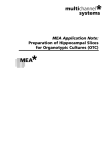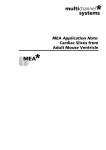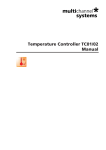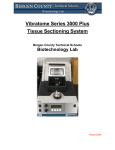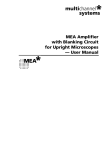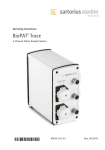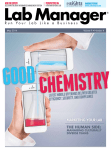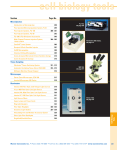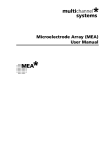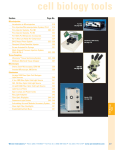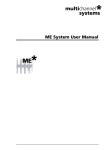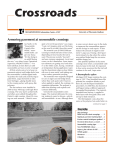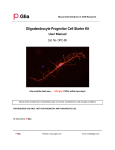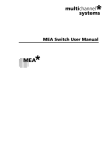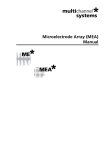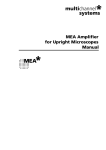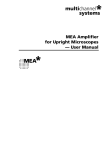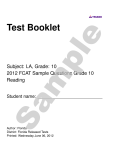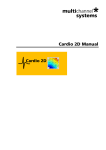Download Primary Culture of Cardiac Myocytes Chicken Embryo Application
Transcript
MEA Preparation Note: Acute Hippocampus Slices from Rattus norvegicus Information in this document is subject to change without notice. No part of this document may be reproduced or transmitted without the express written permission of Multi Channel Systems MCS GmbH. While every precaution has been taken in the preparation of this document, the publisher and the author assume no responsibility for errors or omissions, or for damages resulting from the use of information contained in this document or from the use of programs and source code that may accompany it. In no event shall the publisher and the author be liable for any loss of profit or any other commercial damage caused or alleged to have been caused directly or indirectly by this document. © 2005 Multi Channel Systems MCS GmbH. All rights reserved. Printed: 2005-10-20 Multi Channel Systems MCS GmbH Aspenhaustraße 21 72770 Reutlingen Germany Fon +49-71 21-90 92 5 - 0 Fax +49-71 21-90 92 5 -11 [email protected] www.multichannelsystems.com Products that are referred to in this document may be either trademarks and/or registered trademarks of their respective holders and should be noted as such. The publisher and the author make no claim to these trademarks. Table of Contents 1 1.1 1.2 Introduction About this Application Note Acknowledgement 2 2.1 2.2 2.3 2.4 Material Biological Materials Technical Equipment Chemicals Media 2.4.1 ACSF Buffer 3 3.1 Methods MEA Coating 3.1.1 Planar Standard MEAs 3.1.2 3D-MEAs Setting Up the Vibratome Decapitation and Brain Removal Dissection Preparing Slices Mounting the Slice onto the MEA Preparations for Recording 3.2 3.3 3.4 3.5 3.6 3.7 5 5 5 6 6 6 6 7 7 8 8 8 8 8 9 10 11 12 13 4 4.1 4.2 4.3 Suggested MEA Systems System Configurations Microelectrode Arrays Amplifier Specifications 14 14 14 15 5 Anatomical Details 16 6 References 17 Acute Hippocampus Slice 1 Introduction 1.1 About this Application Note The intention of the MEA Application Notes is to show users how to set up real experiments with the MEA System on the basis of typical applications that are used worldwide. The documents have been written by or with the support of experienced MEA users who like to share their experience with new users. This application note includes a complete protocol for the dissection of rat brain, the preparation of brain hippocampal slices for acute and long term experiments, suggestions for long-term cultures, suggestions for MEA System configurations, and references. 1.2 Acknowledgement Multi Channel Systems would like to thank all MEA users who shared their experience and knowledge with us. A major part of this document is based on the instructions provided by the laboratory of Dr.Ulrich Egert, Freiburg University, Germany. Dr. Ulrich Egert Institut für Biologie III Albert-Ludwigs-Universität Schänzlestrasse 1 79104 Freiburg i. Br. Tel: +49 (761) 203-2862 Fax: +49 (761) 203-2860 URL www.brainworks.uni-freiburg.de 5 MEA Application Note 2 Material 2.1 Biological Materials • 2.2 1 adult rat (for example Wistar Kyoto, Sprague Dawley, or Long Evans, P16–P24) Technical Equipment • MEA System (with amplifier and data acquisition, see Suggested MEA System) • Stimulus generator • MEAs (microelectrode arrays) • Peristaltic pump • Ice • Stereo microscope • Inverted microscope (Necessary for aligning the electrode positions to the slice. If you prefer to use an upright microscope, you need, for example, a camera and a stereo microscope for documenting the electrode position. A picture of the slice on the electrode field can then be loaded into the MC_Rack program for aligning the data traces to the electrodes.) • Oscillating microtome (for example, Integraslice, Campden, Dosalia) and blades • Adjustable pipettes and pipette tips (20 µL and 1000 µL) • Transfer pipettes (cut Pasteur pipettes with wide opening (approximately 0.5 cm) • Large sharp scissors or guillotine • Surgical instruments, for example a bone rongeur or scissors • Narrow flat spatula • Sharp forceps • Curved forceps • Small scissors • Razor blade • Filter paper tips (folded or thick filter paper cut in triangular shape) 2.3 Chemicals • Carbogen gas (95 % O2, 5 % CO2) • NaCl • KCl • CaCl2 • KH2PO4 • NaHCO3 • D-Glucose • MgSO4 • Super glue (cyanoacrylate) • 100 % alcohol or acetone (for cleaning the MEA contact pads) 6 Acute Hippocampus Slice 2.4 Media 2.4.1 ACSF Buffer NaCl 124 mM KCl 3 mM CaCl2 2 mM KH2PO4 1.25 mM NaHCO3 36 mM D-Glucose 10 mM MgSO4 1 mM 1. Prepare the ACSF buffer as listed above. 2. Aerate the medium with carbogen gas for 15 min. 3. Refrigerate 300 mL ACSF buffer until it is partially frozen. 4. Crush the frozen ACSF buffer thoroughly and oxygenate on ice until use. Tip: To speed up the freezing and crushing of ACSF, you might consider to prepare ACSF ice cubes in advance, and store the ice cubes at –80 °C until use. 7 MEA Application Note 3 Methods 3.1 MEA Coating Depending on the type of selected MEA, various coatings may be applied to the MEA surface to promote the adhesion of the slice. Suggestions for coating methods can be found in the MEA User Manual available in the Download section of the MCS web site. 3.1.1 Planar Standard MEAs Standard MEAs should be coated either with cellulose nitrate, with polyethylenimine (PEI), or with poly-D-lysine. 3.1.2 3D-MEAs Due to the three dimensional structure of the recording electrodes, these MEAs do not require coating. However it is recommended to hydrophilize the surface by a two-minute plasma cleaner treatment. As there is no coating applied, cleaning can be done by rinsing off the slice with distilled water. 3.2 Setting Up the Vibratome Note: As the design and handling of different vibratomes varies, please consult the manual of your vibratome for more details. 1. Fill outer vibratome chamber with ice. 2. Fill vibratome chamber with frozen ACSF. You might need to add some room temperature ACSF. Figure 1 8 Vibratome overview: A Brain mounted on agar, and base plate B Oxygenation for ACSF filled inner chamber C Ice filled outer chamber Acute Hippocampus Slice 3.3 Decapitation and Brain Removal The steps after step 2 should be completed within a minute or less to avoid damage of the brain. Avoid mechanical stress on the brain. 1. Anesthetize the rat, for example with 1 mL Isofluoran soaked tissues in a 500 mL beaker covered with aluminum foil. 2. Decapitate the animal with large sharp scissors or a guillotine. 3. Cut the scalp with a scalpel along the midline from caudal to rostral (see fig. A, B). 4. Pull down the skin along the sides of the head by grasping and pulling it between thumb and index finger from below (see fig. B). 5. Skull the cranium carefully with a scissor on ice as follows. This method is simple and fast. It has the disadvantage that the neocortex may get damaged during the procedure. This is generally not a problem as the hippocampus is located inside the temporal lobe and should be safe. a. Midline all the way from foramen magnum to the front end of the brain b. Perpendicular to cut between forebrain and cerebellum c. Perpendicular to (a) along the front end of toward the base of the brain — OR — As an alternative method that allows obtaining an almost undamaged brain: Open the skull with a bone rongeur and carefully remove the skull in pieces (see fig. C). 6. Proceeding from 5c: Fold the two skull segments toward the sides. 7. Quickly remove the brain with the blade of a narrow spatula (see fig. D, E). 8. Briefly wash the brain in a 100 mL beaker filled with ice-cold ACSF buffer. 9. Place the brain in 200 mL ice-cold oxygenated ACSF for 10 min to quickly cool it down (see fig. F). 9 MEA Application Note 3.4 Dissection 1. Place the brain with the dorsal side up onto a filter paper in a Petri dish filled with frozen ACSF. 2. Remove the cerebellum (cut A, see fig. 1). 3. Cut the brain in sagittal plane and separate the hemispheres (cut B, see fig. 1). 4. Remove one hemisphere and store it in cold ACSF until use. 5. Turn the other hemisphere onto the sagittal surface. 6. Cut horizontally a small planar layer from the dorsal side (fig. 2, cut C), in parallel to the bisecting line of the angle formed by the ventral and dorsal area of the brain (see dotted lines, fig. 2). Remove the dorsal piece, which should be less than 2 mm thick, and keep the ventral part for preparing the slices. 7. Remove one third from the rostral end from the forebrain to make the slices smaller (cut D, see fig. 3 and 4). 10 Acute Hippocampus Slice 3.5 Preparing Slices 1. Glue the block of agar onto the base plate with a very small drop of superglue. 2. Place a very small drop of superglue in front of the block. Make sure the drop does not touch the agar. 3. Pick up the trimmed hemisphere with a razor blade, thus that the dorsal plane aligns with the blade. 4. Place the razor blade with the brain against the front side of the agar block and lower it towards the plate (onto the glue). The blade must not touch the glue. 5. Withdraw the blade with an upward motion. You are now looking at the ventral side of the brain (see fig. 6). 6. Place the base plate with the brain into the ACSF filled vibratome chamber. 7. Remove about 3 mm with the first cut — the hippocampus should become visible now (see fig. 7). 8. Slice the brain according to the recommendations of the vibratome’s manufacturer. Typical hippocampal slices are about 350– 450 µm thick. 9. Store the freshly cut slices in oxygenated ACSF for at least 50 min (use a transfer pipette and avoid folding the slice). 11 MEA Application Note 3.6 Mounting the Slice onto the MEA The recommended procedure described in the following instructions fixes the slice onto the coated MEA by adhesion. An alternative method uses small weights (of a few hundred milligrams) to hold down the slice. This method is especially recommended if (uncoated) 3D-MEAs are used. However, this method might stress the slice and result in an altered potential distribution and propagation. You can use either self-made wire grids or a shim with a nylon mesh in the middle to apply the weight. Some steel carriers with nylon meshes as slice hold-downs are also commercially available (for example from Warner Instruments, www.warneronline.com). Commonly used custom made weights are U-shaped flattened pieces of platinum wire (80– 120 mg) glued onto a mesh, a sort of nylon stocking or wedding veil, for example. You can also glue another platinum wire from the other side of the mesh, symmetrically to the first piece of platinum. This kind of grid is less damaging because you can vary the pressure on the slice by changing the thickness of the second wire. The thickness of the wire that is placed onto the slice should match approximately the thickness of the slice. If you use 350 µm slices, the wire should be around 300 µm and not more than 350 µm; otherwise the grid will not hold the slice. Important: Do not touch the slice directly. The slice should not be folded to avoid damage to the tissue. Be careful not to touch the MEA surface with the transfer pipette to avoid damage to the electrodes. 1. Place the slice and a drop of ACSF with the transfer pipette onto the MEA; center it roughly on the recording area. 2. Position the slice by gently pushing it with a pipette tip from the sides into place (see fig. A). The CA1 region should cover the recording area. 3. Remove the ACSF solution to fix the slice onto the MEA: Hold the slice in position with a small pipette tip along the side and remove excess buffer with a 1 mL pipette. 4. Place a filter paper tip next to the slice — without touching it — and remove all remaining buffer (see fig. B and C). This step is critical and should be performed both quickly and carefully. The slice should be almost dry after this step. Repeat this step if necessary, until the slice is attached to the MEA surface. 5. Cover the slice with a few drops of ACSF immediately (see fig. D)— the buffer should be pipetted onto the slice carefully right from the top, rather than from the side, to avoid that the slice is floating up. Avoid falling drops that can damage the tissue. — OR — If you prefer the alternative method of applying weights: → Position the slice in the desired position with approximately 200 µL ACSF left, then apply the weight and add oxygenated ACSF. Some MEA users prefer to nearly dry the hippocampal slice on the array with filter paper wedges; others find it not necessary when using weights and prefer to change the position of the slice if the MEA culture chamber is filled with ACSF. 12 Acute Hippocampus Slice 3.7 Preparations for Recording Note: We recommend the perfusion cannula with temperature control (PH01) for optimal environmental conditions. A two-channel temperature controller (TC02) allows to control both the MEA temperature (via the heating integrated into the amplifier) and the buffer temperature. See the MC_Rack manual or online help for detailed application examples (for example, LTP experiments). For connecting and programming the stimulus generator (STG), please see the respective user manual. Please see the MEA User Manual for details on stimulation amplitudes and times that are supported by the MEA electrodes. Though TiN electrodes are very stable, an unsuitable stimulation pulse will irreversibly damage the electrodes. We highly recommend the following preparations and tests before you start the experiment. 1. Test all connections. 2. Define your virtual rack specific to your application with the MC_Rack program and test it before use. 3. Define your stimulation file with the MC_Stimulus program and test it with the test model probe and with an MEA filled with recording buffer before use. It is recommended to test a range of stimulus amplitudes and locations prior to starting your actual experiment. If you are using an external stimulating electrode, the position of this electrode should be optimized in this step as well. 4. Set up the perfusion system, and test the perfusion with an old MEA. Adjust the grounding and shielding to avoid noise pickup and 50 Hz hum. 5. Set the temperature controller to 37 °C for heating the MEA culture chamber and to 32 °C for the buffer temperature. 6. Start carbogen aeration 15 min before mounting the slice. 7. Start the perfusion 15 min before mounting the slice at a low flow rate (0.5 exchanges/min) to maintain a stable oxygenation and pH. 8. Clean the MEA contacts with a soft tissue and pure alcohol or acetone. 9. Mount the MEA with the slice onto the amplifier as described in the MEA amplifier user manual. 10. Superfuse the slice with oxygenated ACSF solution prewarmed at 32 °C. The buffer volume should be exchanged 3–4 times per minute. The slice is mechanically stressed by activating the perfusion and should be perfused for about half an hour before recording. You can also control the parameter that you want to record, and start the recording as soon as you get a stable baseline, for example, as soon as the spike rate has stabilized. You are now ready for recording. 13 MEA Application Note 4 Suggested MEA Systems 4.1 System Configurations Depending on the throughput and the analysis requirements desired in your laboratory, different system configurations are recommended for the recording from acute hippocampus slice preparations. • MEA60-Inv-System-E: 60-channel MEA recording system for inverted microscopes. The temperature controller TC01/ TC02 regulates the temperature of the MEA and of the perfusion fluid via the perfusion cannula PH01. One MEA amplifier allows recording up to 60 channels from one MEA. The three additional analog inputs can be used for feeding in data generated by other systems recording in parallel, for example, for patch clamp data. The additional digital inputs can be used for synchronizing the recording with the stimulation, or with external systems. This is the standard configuration for low-throughput academic research and high flexibility for a wide range of applications. • MEA60-Inv2-System-E: This system operates 2 MEA amplifiers with a 64-channel data acquisition card. It allows the recording of software-selectable 30 channels per MEA, on two MEAs in parallel. • MEA120-Inv2-System-E / MEA60-Inv4-System-E: These systems are based on a 128 channel data acquisition card and allow the simultaneous operation of two / four amplifiers. These systems provide a throughput suitable for both basic research and industrial applications. 4.2 Microelectrode Arrays Available MEAs differ in electrode material, diameter, and spacing. For an overview on available MEA types please see the Multi Channel Systems web site (www.multichannelsystems.com) or contact your local retailer. The microfold structures formed by titanium nitride (TiN) result in a large surface area that allows the design of small electrodes with a low impedance and an excellent signal to noise ratio. For recordings from the CA1 region, a medium spatial resolution with an electrode diameter of 30 µm and a spacing of 200 µm is generally sufficient. For slice preparations from juvenile rat or adult mouse, a spacing of 100 µm can be useful for increasing the spatial resolution. The following MEAs are recommended for the recording of local field potentials and/or spikes from acute hippocampus slices. • MEA 200/30 i. r.: Standard 8 x 8 layout, TiN electrodes for recording and stimulation, with substrate-integrated reference electrode. • ThinMEA 200/30 i. r. for high-resolution imaging and combination with intracellular calcium measurements. ThinMEAs are only 180 µm “thick” and mounted on a robust ceramic carrier. Tracks and contact pads are made of transparent ITO. • 3D MEAs with tip shaped electrodes generally do not need a precoating. 3-D MEA sensors were specifically designed for acute slices, because the three-dimensionally shaped electrodes penetrate dead cell layers. The platinum electrodes have a diameter of about 40 µm at the base, ending in a fine small tip, with a total height of approx. 50 µm. The interelectrode spacing is 200 µm. 14 Acute Hippocampus Slice 4.3 Amplifier Specifications Though amplifiers with custom gain and bandwidth are available, Multi Channel Systems recommends the following settings for this application. • Lower cutoff frequency: 10 Hz With an even lower value, slow signal drifts will disturb the recordings and spike detection. With 10 Hz, field potentials and spikes can be recorded in parallel. For pure spike recording, a lower cutoff of at 300 Hz would be suitable. However, you can remove local field potentials by digital filtering with the MC_Rack program later. • Upper cutoff frequency: 3 kHz Sufficient even for rapid depolarization waveforms. If only field potentials are of interest, a reduction of the upper cutoff frequency might be considered to reduce high frequency noise. • Gain: 1200 (MEA1060) or 1100 (MEA1060-BC) A note on gain: Traditional amplifiers for extracellular recordings often have 5000x or even 10000x gain switch options. A high gain, however, increases the high frequency noise level or requires a narrower filter band. Considering a 20 µV extracellular signal, we would receive 24 mV after a 1200x amplification. An AD converter with an input range set from – 400mV to 400 mV will resolve the signal in increments of 0.36 µV, which will definitely provide enough information, given the noise level of such systems in general. Therefore, there is no need for higher amplifications. 15 MEA Application Note 5 Anatomical Details The following figures illustrate the position of the hippocampus, slicing levels and the location of the most important functional regions. Figure 2 A View on a mouse hippocampus from the top. The right hemisphere of the neocortex is removed. B Close up view from the right. Figure 3 Hippocampus slice mounted on a standard 200/30 MEA 16 Acute Hippocampus Slice 6 References Egert, U., D. Heck, et al. (2002). "Two-dimensional monitoring of spiking networks in acute brain slices." Exp Brain Res 142(2): 268-74. Egert, U., T. Knott, et al. (2002). "MEA-Tools: an open source toolbox for the analysis of multi-electrode data with MATLAB." J Neurosci Methods 117(1): 33-42. Heuschkel, M. O., M. Fejtl, et al. (2002). "A three-dimensional multi-electrode array for multi-site stimulation and recording in acute brain slices." J Neurosci Methods 114(2): 135-48. Stett, A., U. Egert, et al. (2003). "Biological application of microelectrode arrays in drug discovery and basic research." Anal Bioanal Chem 377(3): 486-95. Wirth, C. and H. R. Luscher (2004). "Spatiotemporal evolution of excitation and inhibition in the rat barrel cortex investigated with multielectrode arrays." J Neurophysiol 91(4): 1635-47. 17

















